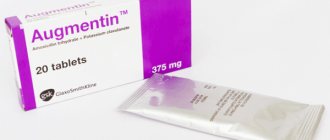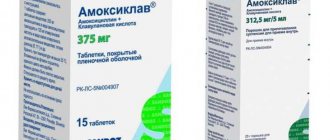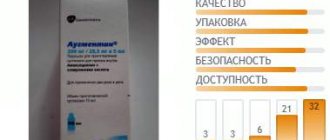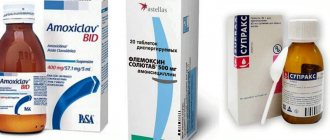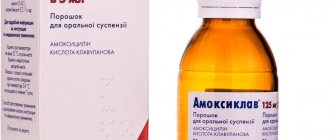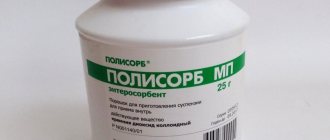Release form and composition
The dosage form of Sumamed forte is a powder for the preparation of a suspension for oral administration: yellowish-white to white in color, with a characteristic aroma of banana, strawberry or raspberry; when dissolved in water, a suspension with a homogeneous structure is formed, from yellowish-white to white, with an aroma corresponding to the smell of the powder [in a polyethylene bottle with a polypropylene resistant cap: with banana aroma - 16.74 g (15 ml), in a cardboard box 1 bottle of 50 ml complete with a syringe and/or measuring spoon for dosing; with strawberry flavor - 29.295 g (30 ml), with raspberry flavor - 35.573 g (37.5 ml), in a cardboard box 1 bottle of 100 ml complete with a syringe and (or) measuring spoon for dosing].
1 g of powder contains:
- active ingredient: azithromycin dihydrate – 50.094 mg (with a theoretical activity of the substance of 95.4%), which is equivalent to the content of 47.79 mg of azithromycin, respectively;
- auxiliary components: xanthan gum, sodium phosphate, sucrose, hyprolose, colloidal silicon dioxide, titanium dioxide;
- flavorings: banana flavor powder - banana flavor and vanilla flavor, strawberry flavor powder - strawberry flavor, raspberry flavor powder - raspberry flavor.
How to breed Sumamed?
Sumamed is available in various forms. To treat children, powder is used; it is diluted to form a suspension. Before taking the drug, you must carefully read the instructions for use.
In it, the manufacturer indicates how to dilute Sumamed to obtain a medicinal suspension. The liquid dosage form is convenient for treating children and adults. The drug is used once a day for 3 days.
When should you take the suspension?
Sumamed belongs to the macrolide group of antibiotics. The main active ingredient in the composition is azithromycin. It is active against many gram-positive bacteria, they cause inflammatory processes when complete recovery is impossible without antibiotics.
Sumamed is prescribed, as a rule, to children. Pediatricians, prescribing a suspension of Sumamed, which is not difficult for an adult to prepare, talk about the effectiveness of the medication in relation to:
- inflammatory processes in the lower and upper respiratory tract;
- for genitourinary infections;
- gastrointestinal diseases as part of complex therapy.
Sumamed in the form of a suspension is used in most cases by parents to treat complications after a cold in a child. These include: pneumonia, bronchitis, tonsillitis, tonsillitis, laryngitis, etc. Only a specialist should prescribe the medicine; it has contraindications and can cause adverse reactions due to incorrect dosage.
Doctors pay special attention to the correct preparation of the suspension and its storage . If these points are violated, the effectiveness of treatment may decrease or be nullified.
The manufacturer indicates the step-by-step procedure for obtaining the medicinal solution. Talks about the importance of storing the medication: store the prepared suspension correctly in a cool place for no more than 5 days.
Antibiotic therapy, as a rule, does not exceed this period. After its expiration, the medicine should be disposed of.
Today the manufacturer offers an additional form of release in powder form - Sumamed Forte.
The medicine is liked by small children; it contains additional components, banana or cherry flavoring. Every parent can make children's Sumamed Forte; you must follow the instructions.
Before performing it, you should definitely weigh the baby; the dosage of the antibiotic is proportional to the child’s weight.
How to prepare a suspension
The medicine is available in various dosages. You can purchase 100 mg/5ml, 200 mg/5ml. The powder is white, the package contains a bottle, a measuring spoon, and a syringe for dosing. To obtain a solution, prepare water. It is advisable to use cleaned or baby food for cooking.
Parents need to follow the instructions. The dosage and dilution method depend on the weight, age of the baby, and the dosage of the drug itself.
- To prepare a suspension of Sumamed 100 mg/5ml , you need to take a special syringe for measurements and fill it with boiled water cooled to room temperature. It is worth adding 12 ml of water for all 100 mg of powder. The result should be a medicinal solution. It must be shaken well so that the suspension is free of lumps. Before each use, it is necessary to remove the medicine from the refrigerator in advance to make it warmer and shake it. This solution is stored for no more than 5 days;
- If the pediatrician prescribed Sumamed powder 200 mg/5ml/15ml, it should be diluted in the same way. You will need boiled water and a measuring syringe, add a volume of 12 ml and mix thoroughly with the powder; An increased dose of 200 mg does not mean that it is necessary to increase the amount of water. Sumamed 100 mg/5 ml should be diluted for the treatment of small patients weighing up to 13 kg in the same way as Sumamed at a dosage of 200 mg/5 ml. A higher dose of the drug indicates a larger amount of antibacterial agent per 5 ml dose.
- For children whose weight exceeds 13 kg, doctors recommend diluting the Sumamed Forte suspension 200 mg/5ml/15 ml . The drug requires an increased dose of antibiotic in one dose. To dilute, you need to add water, as in previous methods, in an amount of 12 ml. Shake the bottle well and take orally as directed by your doctor. The prepared suspension should be stored for no more than 5 days.
The medicine is used for complicated forms of throat diseases, inflammatory processes in the bronchi and lungs. The suspension should be used to treat children from six months to 3 years.
The standard dosage includes:
- one-time dose of 2.5 ml, if the child’s weight varies from 10 to 14 kg;
- from 15 to 24 kg of weight, the dose is doubled and is 5 ml per dose;
- 7.5 ml is prescribed to a patient weighing from 25 to 34 kg;
- From 35 to 44 kg take 10 ml, once a day;
- If the child's weight is above 45 kg, a dosage of 12.5 ml should be used once for 3 days.
For babies whose weight does not exceed 10 kg, pediatricians prescribe the drug in the form of a suspension of 100 mg/5 ml. It contains less antibiotic per dose than 200 mg/5ml. For adults, as a rule, the medicine in the form of a suspension is not prescribed. An exception may be a person’s low body weight, not exceeding 50 kg. In such a situation, you should use Sumamed Forte powder 200 mg/5ml.
If the Sumamed suspension is not suitable for treating the baby, it can be replaced with other analogues . They are also available in liquid form. Some of them have the advantage of not needing to be diluted with water. The most popular analogues of Sumamed, which can be used to treat young patients, include:
- Azimed (complete analogue, in the form of powder for dilution);
- Azitro Sandoz (also in powder form, more expensive, manufactured in Germany);
- Hemomycin (complete analogue, cheaper in cost, in powder form);
- Amoxiclav (a synthesized drug, available in syrup form for the treatment of children).
You should not choose an analogue of Sumamed in the form of a ready-made syrup just because this will avoid preparing the suspension yourself. Any recommendations for the use, discontinuation or replacement of Sumamed with an analogue should only be given by the attending physician.
Source: https://pillsman.org/25040-kak-razvodit-sumamed.html
Pharmacological properties
Pharmacodynamics
Sumamed forte is an antibiotic of the macrolide-azalide group, has the ability to suppress or slow down the growth and reproduction of a wide range of bacteria. The antimicrobial effect is due to the ability of azithromycin to suppress the synthesis of microbial cell protein. After binding to the 50S ribosomal subunit at the translation stage, the antibiotic inhibits peptide translocase and, by inhibiting protein synthesis, slows down the growth and reproduction of bacteria. The bactericidal effect occurs at high concentrations of the drug.
Azithromycin is active against a number of intracellular, anaerobic, gram-positive, gram-negative and other microorganisms.
The following are sensitive to Sumamed forte:
- aerobic gram-positive microorganisms: methicillin-sensitive strains of Staphylococcus aureus, Streptococcus pyogenes, penicillin-sensitive strains of Streptococcus pneumoniae;
- aerobic gram-negative microorganisms: Haemophilus parainfluenzae, Haemophilus influenzae, Legionella pneumophila, Neisseria gonorrhoeae, Pasteurella multocida, Moraxella catarrhalis;
- anaerobic microorganisms: Clostridium perfringens, Porphyromonas speciales (spp.) Fusobacterium spp., Prevotella spp.;
- other microorganisms: Mycoplasma pneumoniae, Chlamydia pneumoniae, Chlamydia trachomatis, Chlamydia psittaci, Borrelia burgdorferi, Mycoplasma hominis.
Gram-positive aerobes - strains with intermediate sensitivity to penicillin and penicillin-resistant strains of Streptococcus pneumoniae - can develop resistance to azithromycin.
The following microorganisms are naturally resistant to Sumamed forte:
- gram-positive aerobes: methicillin-resistant strains of Staphylococcus aureus and Staphylococcus epidermidis, Enterococcus faecalis;
- anaerobes: Bacteroides fragilis.
There are known cases of cross-resistance between beta-hemolytic Streptococcus pyogenes group A, Enterococcus faecalis, Streptococcus pneumoniae and Staphylococcus aureus, including methicillin-resistant strains, to azithromycin, erythromycin and other lincosamides and macrolides.
Pharmacokinetics
The bioavailability of the drug is 37%; after oral administration, its maximum concentration (Cmax) in the blood plasma occurs within 2–3 hours.
Azithromycin binding to plasma proteins is 12–52%. Vd (volume of distribution) of the drug is 31.1 l/kg. The effectiveness of the drug for infections caused by intracellular pathogens is due to its ability to overcome cell membranes. Azithromycin is transported to the site of infection by phagocytes, polymorphonuclear leukocytes and macrophages; there it is released in the presence of bacteria. It enters tissues through easy penetration through histohematic barriers. In tissues and cells, its concentration is 50 times higher than in blood plasma; in healthy tissues, the content of azithromycin is 24–34% less than in the site of infection.
It is demethylated in the liver, losing activity.
It is excreted slowly from tissues, T1/2 (half-life) – 48–96 hours. After taking the last dose, the level of therapeutic concentration of azithromycin continues to be maintained for 168 hours. 50% of the active substance is excreted unchanged by the intestines, and 12% by the kidneys.
In severe renal failure, with creatinine clearance (CC) less than 10 ml/min, T1/2 of the drug increases by 33%.
Sumamed por.d/add.susp.d/internal app.100mg/5ml fl.20.925g 16341
Description
Sumamed® Capsules: hard, gelatin, size No. 1. The color of the body is blue, the lid is blue. Capsule contents: powder or compacted mass from white to light yellow, disintegrating when pressed. Film-coated tablets: blue, round (125 mg) or oval (500 mg), biconvex, engraved “PLIVA” on one side and “125” or “500” on the other. The fractured appearance is white to almost white. Powder for oral suspension: granular powder from white to light yellow in color with a characteristic odor of cherry and banana. After dissolution in water, it becomes a homogeneous suspension from white to light yellow in color with a characteristic odor of cherry and banana. Lyophilisate for the preparation of solution for infusion: lyophilized powder of white or almost white color. Sumamed® forte Powder for the preparation of a suspension for oral administration: granular powder from white to light yellow in color with a characteristic odor of cherry and banana. After dissolution in water, it is a homogeneous suspension from white to light yellow in color with a characteristic odor of cherries and bananas. After oral administration, azithromycin is well absorbed and quickly distributed in the body. After a single oral dose of 500 mg, bioavailability is 37% (first pass effect), Cmax (0.4 mg/ml) in the blood plasma is created after 2–3 hours, apparent Vd is 31.1 l/kg. Plasma protein binding is inversely proportional to blood concentration and ranges from 7–50%. Penetrates through cell membranes (effective against infections caused by intracellular pathogens). Transported by phagocytes, polymorphonuclear leukocytes and macrophages to the site of infection, where it is released in the presence of bacteria. Easily passes through histohematic barriers and enters tissues. The concentration in tissues and cells is 50 times higher than in blood plasma, and at the site of infection it is 24–34% higher than in healthy tissues. Azithromycin has a long T1/2 - 35–50 hours. T1/2 from tissues is much longer. Therapeutic concentrations of azithromycin are maintained for up to 5–7 days after the last dose. Azithromycin is excreted mainly unchanged - 50% through the intestines, 6% by the kidneys. In the liver it is demethylated, losing activity. In patients with severe renal failure (Cl creatinine <10 ml/min), T1/2 of azithromycin increases by 33%. The pharmacokinetics of azithromycin in healthy volunteers after a single intravenous infusion lasting more than 2 hours at a dose of 1000–4000 mg (solution concentration 1 mg/ml) has a linear relationship and is proportional to the administered dose. T1/2 of the drug is 65–72 hours. The high level of observed Vd (33.3 l/kg) and plasma clearance (10.2 ml/min/kg) suggests that the long T1/2 of the drug is a consequence of the accumulation of the antibiotic in tissues followed by its slow release. In healthy volunteers, with an intravenous infusion of azithromycin at a dose of 500 mg (solution concentration 1 mg/ml) for 3 hours, the Cmax of the drug in the blood serum was 1.14 μg/ml. The minimum serum level (0.18 μg/ml) was observed over 24 hours and the AUC was 8.03 μg·h/ml. Similar pharmacokinetic values were obtained in patients with community-acquired pneumonia who were prescribed intravenous infusions (3 hours) for 2 to 5 days. After daily administration of azithromycin at a dose of 500 mg (infusion duration - 1 hour) for 5 days, an average of 14% of the dose is excreted in the urine over a 24-hour dosing interval. Azithromycin is a broad-spectrum bacteriostatic antibiotic from the macrolide-azalide group. Has a wide spectrum of antimicrobial action. The mechanism of action of azithromycin is associated with the suppression of protein synthesis in microbial cells. By binding to the 50S ribosomal subunit, it inhibits peptide translocase at the translation stage and suppresses protein synthesis, slowing down the growth and reproduction of bacteria. In high concentrations it has a bactericidal effect. It is active against a number of gram-positive, gram-negative, anaerobic, intracellular and other microorganisms. Sensitive microorganisms: aerobic gram-positive microorganisms - Staphylococcus aureus (methicillin-sensitive strains), Streptococcus pneumoniae (penicillin-sensitive strains), Streptococcus pyogenes; aerobic gram-negative microorganisms - Haemophilus influenzae, Haemophilus parainfluenzae, Legionella pneumophila, Moraxella catarrhalis, Pasteurella multocida, Neisseria gonorrhoeae; anaerobic microorganisms - Clostridium perfringens, Fusobacterium spp., Prevotella spp., Porphyriomonas spp.; other microorganisms - Chlamydia trachomatis, Chlamydia pneumoniae, Chlamydia psittaci, Mycoplasma pneumoniae, Mycoplasma hominis, Borrelia burgdorferi. Microorganisms with acquired resistance to azithromycin: aerobic gram-positive microorganisms - Streptococcus pneumoniae (penicillin-resistant strains and strains with average sensitivity to penicillin). Microorganisms with natural resistance: aerobic gram-positive microorganisms - Enterococcus faecalis, Staphylococcus aureus (methicillin-resistant strains), Staphylococcus epidermidis (methicillin-resistant strains), anaerobic microorganisms - Bacteroides fragilis. Cases of cross-resistance between Streptococcus pneumoniae, Streptococcus pyogenes (group A beta-hemolytic streptococcus), Enterococcus faecalis and Staphylococcus aureus (methicillin-resistant strains) to erythromycin, azithromycin, other macrolides and lincosamides have been described. Scale of sensitivity of microorganisms to azithromycin (minimum inhibitory concentration - MIC) Microorganisms MIC, mg/l* Sensitive Resistant Staphylococcus ≤1 >2 Streptococcus A, B, C, G ≤0.25 >0.5 Streptococcus pneumoniae ≤0.25 >0 .5 Haemophilus influenzae ≤0.12 >4 Moraxella catarrhalis ≤0.5 >0.5 Neisseria gonorrhoeae ≤0.25 >0.5 * Azithromycin has not been used to treat infectious diseases caused by Salmonella typhi (MIC ≤16 mg/l) and Shigella spp. If you miss one dose of the drug Sumamed®, the missed dose should be taken as soon as possible, and subsequent doses should be taken at intervals of 24 hours. The drug Sumamed® should be used with caution in patients with moderate liver dysfunction due to the possibility of developing fulminant hepatitis and severe liver failure. If there are symptoms of impaired liver function, such as rapidly increasing asthenia, jaundice, darkening of urine, tendency to bleeding, hepatic encephalopathy, therapy with Sumamed® should be stopped and a study of the functional state of the liver should be performed. In case of moderate renal dysfunction (Cl creatinine >40 ml/min), therapy with Sumamed® should be carried out with caution, under monitoring the state of renal function. In end-stage renal failure (Cl creatinine <10 ml/min), there is an increase in the concentration of azithromycin in the blood plasma by 33%. It must be remembered that for the prevention of pharyngitis/tonsillitis caused by Streptococcus pyogenes, as well as for the prevention of acute rheumatic fever, penicillin is usually the drug of choice. As with the use of other antibacterial drugs, during therapy with Sumamed®, patients should be regularly examined for the presence of non-susceptible microorganisms and signs of the development of superinfections, incl. fungal. The drug Sumamed® should not be used for longer courses than indicated in the instructions, because The pharmacokinetic properties of azithromycin allow us to recommend a short and convenient dosage regimen. There is no data on a possible interaction between azithromycin and ergotamine and dihydroergotamine derivatives, but due to the development of ergotism with the simultaneous use of macrolides with ergotamine and dihydroergotamine derivatives, this combination is contraindicated. With long-term use of the drug Sumamed®, the development of pseudomembranous colitis caused by Clostridium difficile, both in the form of mild diarrhea and severe colitis, is possible. If diarrhea develops while taking azithromycin, as well as 2 months after the end of therapy, clostridial pseudomembranous colitis should be excluded. Slow ventricular repolarization syndrome - QT interval prolongation syndrome - increases the risk of developing arrhythmias (including arrhythmias) while taking macrolides, as well as the drug Sumamed®. Caution when using azithromycin should be observed in patients with prolongation of the QT interval, receiving therapy with class IA, III antiarrhythmic drugs, cisapride, hypokalemia or hypomagnesemia, clinically significant bradycardia, arrhythmia or severe heart failure. The use of Sumamed® may provoke the development of myasthenic syndrome or cause an exacerbation of myasthenia. When using Sumamed® and Sumamed® forte in powder form to prepare a suspension for oral administration in patients with diabetes mellitus, as well as on a low-calorie diet, it is necessary to take into account that the suspension contains sucrose (0.32 XE/5 ml). The effectiveness and safety of use in children under 18 years of age of the dosage form of the drug Sumamed®, intended for the preparation of a solution for infusion, has not been established. Patients on a diet with limited sodium intake when treated with Sumamed® should take into account that one bottle contains 198.3 mg of sodium (sodium hydroxide is an excipient). Impact on the ability to drive vehicles and engage in other potentially hazardous activities that require increased concentration and speed of psychomotor reactions. If undesirable effects on the nervous system and organ of vision develop, caution should be exercised when performing actions that require increased concentration and speed of psychomotor reactions.
Compound
Sumamed® Capsules 1 caps. azithromycin (in the form of dihydrate) 250 mg excipients: MCC; sodium lauryl sulfate; magnesium stearate in blister 6 pcs.; 1 blister in a box. Film-coated tablets 1 table. azithromycin dihydrate 131.027 mg 524.109 mg (corresponding to azithromycin - 125 and 500 mg) excipients: core: anhydrous calcium hydrogen phosphate, hypromellose, corn starch, pregelatinized starch, MCC, sodium lauryl sulfate, magnesium stearate shell: hypromellose, indigo carmine dye (E132), polysorbate 80, titanium dioxide (E171), talc in blister 3 (500 mg) or 6 (125 mg) pcs.; 1 blister in a box. Powder for the preparation of suspension for oral administration (prepared suspension) 1 g azithromycin (in the form of dihydrate) 27.17 mg excipients: sucrose, sodium carbonate anhydrous, sodium benzoate, tragacanth, titanium dioxide, glycine, colloidal silicon dioxide, strawberry, apple and mint flavorings in dark glass bottles of 50 ml - 17 g of powder (complete with dosing spoon, dosing syringe); 1 bottle in a box. Lyophilisate for preparing solution for infusion 1 fl. azithromycin (in the form of dihydrate) 524.1 mg (corresponding to azithromycin - 500 mg) excipients: citric acid monohydrate, sodium hydroxide in vials; There are 5 bottles in a cardboard pack. Sumamed® forte Powder for the preparation of suspension for oral administration (prepared suspension) 5 ml azithromycin (in the form of dihydrate) 200 mg excipients: sucrose, trisodium phosphate anhydrous, hydroxypropylcellulose; xanthan gum, cherry flavor J7549, banana flavor 78701-31, vanillin flavor D-125038, colloidal silicon dioxide in bottles of 20, 35 or 42.5 ml (complete with a dosing spoon or dosing syringe); 1 bottle in a box.
Application
Sumamed® Capsules, film-coated tablets, powder for the preparation of a suspension for oral administration Infectious and inflammatory diseases caused by microorganisms sensitive to the drug: infections of the upper respiratory tract and ENT organs (pharyngitis/tonsillitis, sinusitis, otitis media); lower respiratory tract infections (acute bronchitis, exacerbation of chronic bronchitis, pneumonia, including those caused by atypical pathogens); infections of the skin and soft tissues (moderate acne vulgaris, erysipelas, impetigo, secondary infected dermatoses); the initial stage of Lyme disease (borreliosis) - erythema migrans (erythema mygrans); urinary tract infections caused by Chlamidia trachomatis (urethritis, cervicitis) (capsules, film-coated tablets). Lyophilisate for the preparation of a solution for infusion of severe community-acquired pneumonia caused by Chlamydia pneumoniae, Haemophilus influenzae, Legionella pneumophila, Moraxella catarrhalis, Mycoplasma pneumoniae, Staphylococcus aureus, Streptococcus pneumoniae; infectious and inflammatory diseases of the pelvic organs of severe course (endometritis and salpingitis) caused by Chlamydia trachomatis or Neisseria gonorrhoeae and Mycoplasma hominis. Sumamed® forte Powder for the preparation of a suspension for oral administration Infectious and inflammatory diseases caused by microorganisms sensitive to the drug: infections of the upper respiratory tract and ENT organs (pharyngitis/tonsillitis, sinusitis, otitis media); lower respiratory tract infections (acute bronchitis, exacerbation of chronic bronchitis, pneumonia, including those caused by atypical pathogens); infections of the skin and soft tissues (moderate acne vulgaris, erysipelas, impetigo, secondary infected dermatoses); the initial stage of Lyme disease (borreliosis) - erythema migrans (erythema mygrans); urinary tract infections caused by Chlamidia trachomatis (urethritis, cervicitis). Azithromycin is used during pregnancy when the benefit to the mother outweighs the possible risk to the fetus. During treatment with the drug, breastfeeding should be suspended. The frequency of side effects is classified according to WHO recommendations: very often (at least 10%); often (at least 1%, but less than 10%); infrequently (at least 0.1%, but less than 1%); rare (not less than 0.01%, but less than 0.1%); very rare (less than 0.01%, including isolated cases). Infectious diseases: uncommon - candidiasis, incl. mucous membrane of the oral cavity and genitals; very rarely - pseudomembranous colitis. Metabolism and nutrition: often - anorexia. Allergic reactions: often - skin itching, skin rash; uncommon - hypersensitivity reactions, photosensitivity reaction, urticaria, Stevens-Johnson syndrome, angioedema; very rarely - anaphylactic reaction, erythema multiforme, toxic epidermal necrolysis. From the blood and lymphatic system: often - eosinophilia, lymphopenia; uncommon - leukopenia, neutropenia; very rarely - thrombocytopenia, hemolytic anemia. From the nervous system: often - headache, dizziness, paresthesia, disturbance of taste; infrequently - hypoesthesia, drowsiness, insomnia; very rarely - anxiety, aggression, fainting, convulsions, psychomotor hyperactivity, loss of smell (or anosmia) and taste, myasthenia gravis, anxiety. From the side of the organ of vision: often - blurred vision. From the organ of hearing and labyrinthine disorders: often - deafness; infrequently - tinnitus; rarely - vertigo. From the cardiovascular system: infrequently - palpitations; very rarely - decreased blood pressure, increased QT interval, arrhythmias, ventricular tachycardia. From the gastrointestinal tract: very often - nausea, flatulence, abdominal pain, diarrhea; often - dyspepsia, vomiting; infrequently - constipation, gastritis; very rarely - change in tongue color, pancreatitis. From the liver and biliary tract: infrequently - increased activity of liver transaminases, increased concentration of bilirubin, hepatitis; rarely - liver dysfunction; very rarely - cholestatic jaundice, liver failure (in rare cases with death, mainly due to severe liver dysfunction); liver necrosis, fulminant hepatitis. From the musculoskeletal system and connective tissue: often - arthralgia. From the kidneys and urinary tract: infrequently - increased concentrations of urea and creatinine in the blood plasma; very rarely - interstitial nephritis, acute renal failure. Other: often - weakness; uncommon - chest pain, peripheral edema, asthenia, malaise, changes in potassium concentration. Antacids do not affect the bioavailability of azithromycin, but reduce Cmax in blood plasma by 30%, so azithromycin should be taken at least 1 hour before or after 2 hours after taking these drugs or eating. Azithromycin does not affect the plasma concentrations of carbamazepine, cimetidine, didanosine, efavirenz, fluconazole, indinavir, midazolam, theophylline, triazolam, trimethoprim/sulfamethoxazole, cetirizine, sildenafil, atorvastatin, rifabutin and methylprednisolone when used simultaneously. If simultaneous use with cyclosporine is necessary, it is recommended to monitor the concentration of cyclosporine in the blood plasma. When using digoxin and azithromycin simultaneously, it is necessary to monitor the concentration of digoxin in the blood plasma, because many macrolides increase the absorption of digoxin in the intestine. If simultaneous use with indirect anticoagulant agents (warfarin, other coumarin-type anticoagulants) is necessary, careful monitoring of PT is recommended. The simultaneous use of terfenadine and macrolide antibiotics has been found to cause arrhythmia and prolongation of the QT interval. Based on this, the above complications cannot be excluded when taking terfenadine and azithromycin simultaneously. When used simultaneously with nelfinavir, an increase in the frequency of adverse reactions from azithromycin is possible. The possibility of inhibition of the CYP3A4 isoenzyme by azithromycin should be taken into account when used simultaneously with cyclosporine, terfenadine, ergot alkaloids, cisapride, pimozide, quinidine, astemizole and other drugs whose metabolism occurs with the participation of this isoenzyme. When used concomitantly with zidovudine, azithromycin does not affect the pharmacokinetic parameters of zidovudine in the blood plasma or the renal excretion of it and its glucuronide metabolite. However, the concentration of the active metabolite, phosphorylated zidovudine, increases in mononuclear cells of peripheral vessels. The clinical significance of this fact is unclear. When macrolides are used simultaneously with ergotamine and dihydroergotamine, their toxic effects may occur. Sumamed® Capsules Orally, 1 time per day, at least 1 hour before or 2 hours after meals. The drug in this dosage form is prescribed to adults (including the elderly) and children over 12 years of age weighing over 45 kg. For infections of the upper and lower respiratory tract, ENT organs, skin and soft tissues: 500 mg (2 caps.) 1 time per day for 3 days; course dose - 1.5 g. For erythema migrans: prescribed once a day for 5 days. On the 1st day - 1 g (4 capsules), then from the 2nd to the 5th day - 500 mg (2 capsules); course dose - 3 g. For urinary tract infections caused by Chlamidia trachomatis (urethritis, cervicitis): uncomplicated urethritis/cervicitis - 1 g (4 caps.) once. Patients with impaired renal function: for patients with moderate impaired renal function (Cl creatinine >40 ml/min) no dose adjustment is required. Film-coated tablets Take orally, without chewing, at least 1 hour before or 2 hours after meals, 1 time per day. Adults and children over 12 years of age weighing more than 45 kg For infections of the upper and lower respiratory tract, ENT organs, skin and soft tissues: 1 table. (500 mg) 1 time per day for 3 days; course dose - 1.5 g. For acne vulgaris of moderate severity: 1 table. (500 mg) 1 time per day for 3 days, then 1 tablet. (500 mg) once a week for 9 weeks; course dose - 6 g. The first weekly tablet should be taken 7 days after taking the first daily tablet (8th day from the start of treatment), the next 8 weekly tablets - with an interval of 7 days. For Lyme disease (the initial stage of borreliosis) - erythema migrans: 1 time per day for 5 days. On the 1st day - 1 g (2 tablets of 500 mg each), then from the 2nd to the 5th day - 1 tablet. (500 mg); course dose - 3 g). For urinary tract infections caused by Chlamidia trachomatis (urethritis, cervicitis): uncomplicated urethritis/cervicitis - 1 g (2 tablets of 500 mg each) once. Children aged 3 to 12 years weighing less than 45 kg For infections of the upper and lower respiratory tract, ENT organs, skin and soft tissues: the drug is prescribed at a rate of 10 mg/kg 1 time per day for 3 days; course dose - 30 mg/kg. For ease of dosing, it is recommended to use the table below. Calculation of the dose of Sumamed® for children weighing less than 45 kg Body weight, kg Dose of azithromycin tablets 125 mg 18–30 2 tables. (250 mg azithromycin) 31–44 3 tab. (375 mg of azithromycin) not less than 45 Doses recommended for adults are used. In children under 3 years of age, it is recommended to use the drug Sumamed®, powder for the preparation of an oral suspension, 100 mg/5 ml. For pharyngitis/tonsillitis caused by Streptococcus pyogenes, the drug Sumamed® is used at a dose of 20 mg/kg/day for 3 days; course dose 60 mg/kg. The maximum daily dose is 500 mg. For Lyme disease (initial stage of borreliosis) - erythema migrans: 20 mg/kg 1 time per day on the 1st day, then at the rate of 10 mg/kg 1 time per day from the 2nd to the 5th day. For ease of use in children, a course dose of 60 mg/kg is recommended to take the drug Sumamed®, powder for the preparation of an oral suspension, 100 mg/5 ml. If renal function is impaired: in patients with moderate renal impairment (Cl creatinine >40 ml/min), no dose adjustment is required. For liver dysfunction: for moderate liver dysfunction, no dose adjustment is required. Powder for the preparation of a suspension for oral administration, 1 time per day, 1 hour before or 2 hours after meals. After taking Sumamed®, the child must be offered to drink a few sips of water so that he can swallow the remainder of the suspension. Before each dose of the drug, the contents of the bottle are thoroughly shaken until a homogeneous suspension is obtained. If the required volume of suspension was not taken from the bottle within 20 minutes after shaking, the suspension should be shaken again, the required volume should be taken and given to the child. The required dose is measured using a dosing syringe with a division value of 1 ml and a nominal suspension capacity of 5 ml (200 mg azithromycin) or a measuring spoon with a nominal suspension capacity of 2.5 ml (100 mg azithromycin) or 5 ml (200 mg azithromycin), inserted in a cardboard package along with the bottle. After use, the syringe (after disassembling it) and measuring spoon are washed with running water, dried and stored in a dry place until the next dose of Sumamed®. For infections of the upper and lower respiratory tract, ENT organs, skin and soft tissues: the drug is prescribed at a rate of 10 mg/kg once a day for 3 days; course dose - 30 mg/kg. For precise dosing of the drug Sumamed® in accordance with the child’s body weight, use the table below. Body weight, kg Volume of suspension for 1 dose 5 2.5 ml (50 mg azithromycin) 6 3 ml (60 mg azithromycin) 7 3.5 ml (70 mg azithromycin) 8 4 ml (80 mg azithromycin) 9 4.5 ml (90 mg azithromycin) 10 5 ml (100 mg azithromycin) For pharyngitis/tonsillitis caused by Streptococcus pyogenes, the drug Sumamed® is used at a dose of 20 mg/kg/day for 3 days; course dose 60 mg/kg. The maximum daily dose is 500 mg. For Lyme disease (initial stage of borreliosis) - erythema migrans: on the 1st day at a dose of 20 mg/kg/day, then from the 2nd to the 5th day at a dose of 10 mg/kg/day; course dose 60 mg/kg. Patients with impaired renal function: in case of impaired renal function (Cl creatinine >40 ml/min), no dose adjustment is required. Patients with hepatic impairment: No dosage adjustment is required for moderate hepatic impairment. Preparation and storage of the suspension To the contents of the bottle intended for the preparation of 20 ml of suspension (nominal volume), add 11 ml of water using a dosing syringe. Shake until a homogeneous suspension is obtained. The volume of the resulting suspension will be about 25 ml, which exceeds the nominal volume by approximately 5 ml. This is provided to compensate for the inevitable losses of suspension when dosing the drug. The prepared suspension can be stored at a temperature not exceeding 25 °C for no more than 5 days. Lyophilisate for preparing a solution for intravenous infusion by drip, for 3 hours - at a concentration of 1 mg/ml, for 1 hour - at a concentration of 2 mg/ml. Higher concentrations should be avoided due to the risk of injection site reactions. Sumamed® cannot be administered intravenously or intramuscularly. Community-acquired pneumonia: 500 mg once a day for at least 2 days. If necessary, by the decision of the attending physician, the course can be extended, but should not exceed 5 days. After completing the IV administration, it is recommended to prescribe azithromycin orally at a daily dose of 500 mg until the 7-10-day general course of treatment is completed. Infectious and inflammatory diseases of the pelvic organs: 500 mg once a day for 2 days. The course of treatment is no more than 5 days. After completing the IV administration, it is recommended to prescribe azithromycin orally at a dose of 250 mg until the 7-day general course of treatment is completed. The timing of the transition from intravenous administration of the drug Sumamed® to oral administration is determined by the doctor in accordance with the data of the clinical examination. Patients with impaired renal function: no dose adjustment is required. Preparation of solution for infusion The solution for infusion is prepared in 2 stages. Stage 1 - preparation of the reconstituted solution. Add 4.8 ml of sterile water for injection to a bottle containing 500 mg of the drug and shake thoroughly until the powder is completely dissolved. 1 ml of the resulting solution contains 100 mg of azithromycin. The reconstituted solution should be used immediately for further dilution. The reconstituted solution is checked to ensure that there are no visible undissolved particles, otherwise the solution should not be used. Stage 2 - dilution of the reconstituted solution (100 mg/ml). It is carried out immediately before administration in accordance with the table below. Concentration of azithromycin in the infusion solution, mg/ml Amount of solution for dilution, ml 1,500 2,250 The reconstituted solution is added to a bottle with a solvent (0.9% sodium chloride solution, 5% dextrose solution, Ringer's solution) to obtain the final concentration of azithromycin 1– 2 mg/ml in infusion solution. The prepared solution is checked for the absence of visible undissolved particles, otherwise the solution should not be used. The prepared diluted solution should be used immediately. Sumamed® forte Powder for the preparation of a suspension for oral administration, 1 time per day, 1 hour before or 2 hours after meals. After taking Sumamed® forte, the child must be offered to drink a few sips of water so that he can swallow the remainder of the suspension. Before each dose of the drug, the contents of the bottle are thoroughly shaken until a homogeneous suspension is obtained. If the required volume of suspension was not taken from the bottle within 20 minutes after shaking, the suspension should be shaken again, the required volume should be taken and given to the child. The required dose is measured using a dosing syringe with a division value of 1 ml and a nominal suspension capacity of 5 ml (200 mg azithromycin) or a measuring spoon with a nominal suspension capacity of 2.5 ml (100 mg azithromycin) or 5 ml (200 mg azithromycin), inserted in a cardboard package along with the bottle. After use, the syringe (after disassembling it) and measuring spoon are washed with running water, dried and stored in a dry place until the next dose of Sumamed® forte. For infectious and inflammatory diseases of the upper and lower respiratory tract, skin and soft tissues: the drug is prescribed at the rate of 10 mg/kg once a day for 3 days; course dose - 30 mg/kg. To accurately dose Sumamed® forte according to the child’s body weight, use the table below. Body weight, kg Volume of suspension for 1 dose 10–14 2.5 ml suspension (100 mg azithromycin) 15–24 5 ml suspension (200 mg azithromycin) 25–34 7.5 ml suspension (300 mg azithromycin) 35–44 10 ml of suspension (400 mg azithromycin) not less than 45 12.5 ml of suspension (500 mg azithromycin) (corresponds to the dose for adult patients) For pharyngitis/tonsillitis caused by Streptococcus pyogenes, the drug Sumamed® forte is used at a dose of 20 mg/kg/day within 3 days; course dose 60 mg/kg. The maximum daily dose is 500 mg. Children weighing up to 10 kg should take Sumamed®, powder for oral suspension, 100 mg/5 ml. For Lyme disease (initial stage of borreliosis) - erythema migrans: on the 1st day at a dose of 20 mg/kg/day, then from the 2nd to the 5th day at a dose of 10 mg/kg/day; Course dose 60 mg/kg. Patients with impaired renal function: In case of impaired renal function (CL creatinine> 40 ml/min), the dose correction is not required. Patients with impaired liver function: with a moderate impaired liver function, dose correction is not required. The preparation and storage of the suspension for the contents of the bottle intended for the preparation of 15 ml of the suspension (nominal volume), 8 ml of water is added using a dosage syringe. Shake until a homogeneous suspension is obtained. The volume of the resulting suspension will be about 20 ml, which exceeds the nominal volume by approximately 5 ml. This is provided to compensate for the inevitable loss of suspension when dosing the drug. The prepared suspension can be stored at a temperature of not higher than 25 ° C for no more than 5 days. 14.5 ml of water are added to the contents of the bottle intended for the preparation of 30 ml of suspension (nominal volume). Shake until a homogeneous suspension is obtained. The volume of the resulting suspension will be about 35 ml, which exceeds the nominal volume by approximately 5 ml. This is provided to compensate for the inevitable loss of suspension when dosing the drug. The prepared suspension can be stored at a temperature of not higher than 25 ° C for no more than 10 days. The contents of the bottle intended for the preparation of 37.5 ml of the suspension (nominal volume), 16.5 ml of water are added using a dosage syringe. Shake until a homogeneous suspension is obtained. The volume of the resulting suspension will be about 42.5 ml, which exceeds the nominal volume by approximately 5 ml. This is provided to compensate for the inevitable loss of suspension when dosing the drug. The prepared suspension can be stored at a temperature of not higher than 25 ° C no more than 10 days. Simptoms: nausea, temporary hearing loss, vomiting, diarrhea, abdominal pain, and impaired liver function. Treatment: gastric lavage, symptomatic therapy (taking activated coal), control of vital functions. Sumamed® capsules, lyophilisate for the preparation of a solution for infusion increased sensitivity to azithromycin, other macrolides or other components of the drug; severe liver failure (class C through Child-Pew); severe impaired renal function (CL creatinine <40 ml/min); Children's age up to 12 years with body weight up to 45 kg; breastfeeding period; Simultaneous intake with ergotamin and digidroergotamin. With caution: pregnancy; myasthenia gravis; moderate disorders of the liver function; moderate kidney function disorders (CL creatinine> 40 ml/min); with arrhythmias or predisposition to arrhythmias and lengthening of the QT interval; The simultaneous use of terphenin, warfarin, digoxin. Tablets covered with a film shell increased sensitivity to azithromycin, other macrolides or other components of the drug; impaired liver function of a severe degree; severe impaired renal function (CL creatinine <40 ml/min); Children's age up to 12 years with a body weight of less than 45 kg (for tablets 500 mg); Children's age up to 3 years (for tablets 125 mg); breastfeeding period; Simultaneous intake with ergotamin and digidroergotamin. With caution: pregnancy; myasthenia gravis; moderate disorders of the liver function; moderate kidney function disorders (CL creatinine> 40 ml/min); in patients with lengthening the QT interval receiving therapy with antiarrhythmic means of classes IA, III, CIZAPARATION, with hypocalyemia or hypomagnesia, clinically significant bradycardia, arrhythmia or severe heart failure; The simultaneous use of terphenin, warfarin, digoxin. Powder for preparing a suspension for oral administration to antibiotics of the macrolide group; severe dysfunction of the liver and kidneys; Children's age up to 6 months; breastfeeding period; Simultaneous intake with ergotamin and digidroergotamin. With caution: pregnancy; myasthenia gravis; moderate disorders of the liver function; moderate kidney function disorders (CL creatinine> 40 ml/min); in patients with lengthening the QT interval receiving therapy with antiarrhythmic means of classes IA, III, CIZAPARATION, with hypocalyemia or hypomagnesia, clinically significant bradycardia, arrhythmia or severe heart failure; The simultaneous use of terphenin, warfarin, digoxin, diabetes mellitus. Sumamed® Fort Powder for preparing a suspension for oral administration increased sensitivity to azithromycin, other macrolides or other components of the drug; violation of the liver function of a severe degree (no data on efficiency and safety); impaired renal function (CL creatinine <40 ml/min) (no data on efficiency and safety); sucrhasis/isomaltase deficiency, fructose intolerance, glucose-galactose malabsorption; Children's age up to 6 months; breastfeeding period; Simultaneous intake with ergotamin and digidroergotamin. With caution: pregnancy; myasthenia gravis; moderate disorders of the liver function; moderate kidney function disorders (CL creatinine> 40 ml/min); in patients with lengthening the QT interval receiving therapy with antiarrhythmic tools of classes IA, III, CIZAPARATION, with hypocalyemia or hypomagnesia, clinically significant bradycardia, arrhythmia or severe heart failure; The simultaneous use of terphenin, warfarin, digoxin, diabetes mellitus.
Possible product names
- Sumamed por.d/susp. 100mg/5ml vial. 17g
- SUMAMED 100 MG/5 ML POR. D/SUSPENSIONS
- SUMAMED POR D/SUSP 100 MG/5ML FLAC 17G/50ML
- SUMAMED POR. D/SUSP.100 MG/5ML FL. 20.925 G V SET. WITH DOSING SPOON X1
- SUMAMED POR. COOK. SUSP. D\VN. TAKING 100MG/5ML FL. 20.925 V SET WITH MEASURING SPOON AND SYRINGE D\DOSE. №1 (STRAWBERRY)
- SUMAMED 100MG/5ML SOURCE FOR PREPARATION OF SUSP.D.ORDER INTERNALLY. FL. PE 50ML (25ML - READY SUSP.) M (R)
Indications for use
According to the instructions, Sumamed forte is indicated for the treatment of infectious and inflammatory diseases caused by microorganisms sensitive to the drug, including:
- pharyngitis or tonsillitis, otitis media, sinusitis and other upper respiratory tract infections;
- exacerbation of chronic bronchitis, acute bronchitis, community-acquired pneumonia and other lower respiratory tract infections;
- impetigo, erysipelas, secondary infected dermatoses and other infections of the skin and soft tissues;
- erythema migrans (Erythema Migrans) – Lyme disease (first stage of borreliosis).
Reviews from parents
Ekaterina, Odessa
“Last year my son became very ill. A diagnosis of purulent tonsillitis was made. The child literally did not get out of bed. Sumamed got him back on his feet in a few days. The improvement was noticeable already on the second day, the temperature went away and the sore throat decreased. A very good remedy."
Anna, St. Petersburg
“I have always treated antibiotics with extreme caution, because they often cause various side effects. Not long ago I had to give this drug to my daughter because she became very ill with bronchitis. We were treated with Sumamed. I can only say good things about the medicine. It helped quickly, and there were no side effects. I recommend".
Antonina, Lyubertsy
“Sumamed suspension for children helps very well. I can guarantee this from my own experience. We have already been treated with this medicine three times and each time the effect is excellent. The advantages also include ease of use. The disadvantage is the rather high price."
Valeria, Moscow
“I heard that children need to be given antibiotics only in extreme cases, because they kill not only harmful, but also beneficial microorganisms. We had to give this remedy to a child with pneumonia. They underwent inpatient treatment. Fortunately, everything ended well, my daughter did not experience any side effects. The main thing is to strictly follow all the doctor’s instructions.”
Contraindications
- severe liver dysfunction;
- severe renal dysfunction;
- fructose intolerance, sucrase or isomaltase deficiency, glucose-galactose malabsorption syndrome;
- simultaneous use of ergotamine and dihydroergotamine;
- breast-feeding;
- individual intolerance to erythromycin, macrolides or ketolides;
- hypersensitivity to the components of the drug.
Sumamed forte is not prescribed to children under the age of 6 months.
Caution must be exercised when prescribing the drug to patients with myasthenia gravis, mild to moderate liver dysfunction, end-stage renal failure (creatinine clearance less than 10 ml/min), diabetes mellitus, while using digoxin, warfarin or cyclosporine; in the presence (especially in elderly patients) of the following proarrhythmogenic factors: simultaneous therapy with antiarrhythmic drugs of class IA (procainamide, quinidine), III (sotalol, dofetilide, amiodarone), terfenadine, cisapride, antipsychotics (pimozide), fluoroquinolones (levofloxacin, moxifloxacin), antidepressants (citalopram), congenital or acquired prolongation of the QT interval, water and electrolyte imbalance, especially with hypokalemia or hypomagnesemia, cardiac arrhythmia, clinically significant bradycardia, severe heart failure.
During pregnancy, the use of Sumamed forte is indicated only in special cases, if the benefit of treatment for the mother outweighs the potential threat to the fetus and child.
Analogs
Level 4 ATC code matches:
Ecositrin
Azicine
Rovamycin
AzitRus
Safocid
Clarithromycin
Klarbakt
Azithromycin
Azitro Sandoz
Sumamed
ZI-Factor
Azitral
Azimed
Azicide
Spiramycin-Vero
Zitrolide
Ecomed
Macropen
Klacid SR
Klacid
Azivon, Azivok, Azidrop, Azitral, Azilide, Azithromycin Zentiva, Azithromycin Sandoz, Sumamecin, Azithromycin, AzitRus, Azicide, Zetamax retard, Sumamox, Vero-Azithromycin, ZI-Factor, Zitnob, Zithrocin, Sumaklid, Zitrolide, Sumaside, Sumamed, Sumatrolide Solutab, Azitrox, Tremak-Sanovel, Azimicin, Hemomycin, Ecomed.
Instructions for use of Sumamed forte: method and dosage
The prepared suspension is taken 1 hour before meals or 2 hours after meals, 1 time per day. After taking the drug, children should be given a small amount of water to drink so that they can swallow the remainder of the suspension.
To prepare the suspension, add water to the contents of the bottle using a dosing syringe. When dissolving the powder, the following proportions must be strictly observed:
- bottle with 16.74 g of powder: to obtain 15 ml of suspension, add 9.5 ml of water to the bottle. The resulting volume of suspension will be approximately 20 ml. Shelf life – no more than 5 days;
- bottle with 29.295 g of powder: to obtain 30 ml of suspension, add 16.5 ml of water to the bottle. The resulting volume of suspension is about 35 ml. Shelf life – no more than 10 days;
- bottle with 35.573 g of powder: to obtain 37.5 ml of suspension, add 20 ml of water to the bottle. The resulting volume is approximately 42.5 ml. Shelf life - no more than 10 days.
After mixing the drug with water, the bottle is shaken to obtain a homogeneous suspension structure. The amount of suspension in each bottle exceeds the nominal volume by approximately 5 ml. This is provided in order to compensate for natural losses during dosing of the drug.
The suspension should be stored at temperatures up to 25 °C.
The contents of the bottle must be shaken thoroughly before each dose of the drug and taken immediately.
The prescribed dose of Sumamed forte is measured using the dosing syringe included in the package (division value - 1 ml, nominal capacity - 5 ml of suspension, or 200 mg of azithromycin) or measuring spoon (nominal capacity - 2.5 or 5 ml of suspension, which corresponds to 100 mg and 200 mg azithromycin).
After use, the syringe (pre-disassembled) and measuring spoon must be rinsed with running water, dried and stored in a dry place until the next dose.
The dose of Sumamed forte is determined by the doctor based on clinical indications.
For the treatment of children weighing up to 10 kg, it is recommended to prescribe Sumamed powder to prepare an oral suspension containing 100 mg of azithromycin per 5 ml of suspension. When using a measuring spoon to dose this form of the drug, it should be taken into account that a 2.5 ml measuring spoon contains 50 mg, and a 5 ml measuring spoon contains 100 mg of azithromycin.
For children, Sumamed forte 200 mg/5 ml is indicated in the following accordance with the child’s weight:
- 10–14 kg: 2.5 ml (100 mg azithromycin);
- 15–24 kg: 5 ml (200 mg);
- 25–34 kg: 7.5 ml (300 mg);
- 35–44 kg: 10 ml (400 mg);
- 45 kg and above: 12.5 ml (500 mg, which corresponds to a single dose for adult patients).
Recommended daily dosage of Sumamed forte:
- infectious and inflammatory diseases of the upper and lower respiratory tract, soft tissues and skin: at the rate of 10 mg per 1 kg of body weight, course duration - 3 days, course dose - 30 mg per 1 kg;
- tonsillitis or pharyngitis caused by Streptococcus pyogenes: 20 mg per 1 kg, but not more than 500 mg per day. Duration of treatment – 3 days, dose for 1 course – 60 mg per 1 kg of weight;
- Lyme disease: on day 1 – 20 mg per 1 kg, from days 2 to 5 – 10 mg per 1 kg of weight. The maximum dose of one course is 60 mg per 1 kg.
In case of functional renal impairment, the recommended dose is not adjusted in patients with CC 10–80 ml/min.
In case of mild to moderate liver dysfunction and when treating elderly patients, the recommended doses should not be reduced.
Overdose
If the dosage is exceeded, nausea, diarrhea, vomiting, and temporary hearing loss occur. In such cases, it is recommended to take activated carbon and consult a doctor.
Sumamed dosage for children under 12 years of age
Calculated depending on the child's weight. For every 10 kg of weight there should be 10 mg of the active substance. This dose is usually taken for three days, once a day. During the entire course of treatment, the child will take 30 mg of the drug for every 10 kg of his weight.
Dosage from 12 years
From 12 years of age, the standard treatment regimen lasts three or five days. With a three-day regimen, the child takes 2 tablets with a dosage of 500 mg twice a day for three days. With a five-day regimen, two tablets are taken on the first day, and on the remaining days, one 500 mg tablet is taken every day.
Side effects
- from the nervous system: often – headache; uncommon – paresthesia, insomnia, taste disturbances, dizziness, nervousness, drowsiness; rarely – agitation; possible (frequency unknown) - psychomotor hyperactivity, hypoesthesia, anxiety, fainting, convulsions, aggression, loss of taste, loss of smell, myasthenia gravis, perverted sense of smell, hallucinations, delirium;
- infectious diseases: infrequently - rhinitis, pneumonia, candidiasis (including the mucous membrane of the mouth, genitals), pharyngitis, respiratory diseases, gastroenteritis; very rarely - pseudomembranous colitis;
- from the cardiovascular system: infrequently - a rush of blood to the skin of the face, a feeling of palpitations; possible - ventricular tachycardia, decreased blood pressure (BP), prolongation of the QT interval on electrocardiography, pirouette-type arrhythmia;
- from the blood and lymphatic system: infrequently – leukopenia, eosinophilia, neutropenia; very rarely - hemolytic anemia, thrombocytopenia;
- allergic reactions: uncommon – hypersensitivity reaction, angioedema; possibly an anaphylactic reaction;
- labyrinthine and hearing disorders: infrequently – vertigo, hearing impairment; possibly – tinnitus, deafness;
- from the organ of vision: infrequently – visual impairment;
- from the respiratory system: infrequently – nosebleeds, shortness of breath;
- from the gastrointestinal tract: very often – diarrhea; often – abdominal pain, nausea, vomiting; uncommon – constipation, dryness of the oral mucosa, increased secretion of the salivary glands, flatulence, dyspepsia, gastritis, dysphagia, belching, bloating, ulceration of the oral mucosa; very rarely - pancreatitis, change in tongue color;
- from the hepatobiliary system: infrequently – hepatitis; rarely – cholestatic jaundice, functional liver disorder; possible - fulminant hepatitis, liver failure (including fatal), liver necrosis;
- from the urinary system: infrequently – pain in the kidneys, dysuria; possibly – acute renal failure, interstitial nephritis;
- from the genital organs and mammary gland: infrequently - testicular dysfunction, metrorrhagia;
- from the musculoskeletal system: infrequently – back pain, osteoarthritis, neck pain, myalgia; possibly arthralgia;
- on the part of metabolism and nutrition: infrequently – anorexia;
- dermatological reactions: uncommon - dry skin, itching, skin rash, dermatitis, sweating, urticaria; rarely – photosensitivity reaction; possibly - erythema multiforme, Stevens-Johnson syndrome, toxic epidermal necrolysis;
- laboratory indicators: often - a decrease in the level of bicarbonates in the blood plasma, a decrease in the number of lymphocytes, an increase in the number of basophils, eosinophils, monocytes and (or) neutrophils; infrequently - increased blood glucose levels, increased activity of alanine aminotransferase and aspartate aminotransferase, increased levels of bilirubin, urea and (or) creatinine in the blood plasma, impaired potassium concentration in the blood plasma, increased activity of alkaline phosphatase in the blood plasma, increased amount of chlorine and (or ) bicarbonates in the blood plasma, increased hematocrit, impaired sodium levels in the blood plasma, increased platelet levels;
- other: uncommon – feeling of fatigue, asthenia, peripheral edema, malaise, facial swelling, fever, chest pain.
special instructions
Patients with diabetes mellitus and patients on a low-calorie diet should take into account that the carbohydrate content in 5 ml of suspension (200 mg per 5 ml) corresponds to 0.32 XE.
If you accidentally miss the next dose of the drug, the patient should take it as soon as he remembers; then continue taking it at intervals of 24 hours.
When concomitantly treated with antacids, Sumamed Forte should be taken 1 hour before or 2 hours after taking them.
With mild to moderate severity of liver dysfunction, there is a risk of developing fulminant hepatitis and severe liver failure. The drug should be stopped if the following symptoms of liver dysfunction are present: dark urine, rapidly increasing asthenia, bleeding tendency, jaundice, hepatic encephalopathy - and conduct a liver function test.
During the treatment period, patients need regular examination for the presence of non-susceptible microorganisms and signs of the development of superinfections, including fungal ones.
The recommended duration of therapy should not be exceeded.
Long-term use of Sumamed forte may contribute to the development of mild diarrhea or severe pseudomembranous colitis caused by Clostridium difficile. Patients who have had antibiotic-associated diarrhea while taking the drug should be examined to exclude clostridial pseudomembranous colitis, including 2 months after discontinuation of therapy. Do not use drugs that inhibit intestinal motility.
Azithromycin has the effect of prolonging cardiac repolarization and the QT interval, which increases the risk of developing cardiac arrhythmias (including torsade de pointes), including cardiac arrest. In addition, the drug may contribute to the development of myasthenic syndrome or exacerbation of myasthenia.
Impact on the ability to drive vehicles and complex mechanisms
Since Sumamed forte can cause the development of undesirable effects on the organ of vision and the nervous system, it is recommended to exercise caution during the treatment period when driving vehicles, machinery and other activities that require a high speed of psychomotor reactions and concentration.
Sumamed for children – video
Watch this short video to see how easy it is to prepare the suspension. You will also learn that the genuine Sumamed drug must have 2 protective stickers, the removal of which is impossible without damaging the packaging. Therefore, when purchasing, pay attention to the presence of such stickers.
Now you know that some bacterial infections require the use of an antibiotic. One of the modern universal antibiotics is Sumamed. It has a short course of use, is generally well tolerated by children and is highly effective.
Never self-medicate or take such serious drugs as Sumamed without a doctor’s prescription! He will study the medical history, assess the baby’s condition and make a decision on the appointment. In the comments, share what diseases of your baby you managed to overcome with the help of Sumamed.
Drug interactions
With simultaneous use of Sumamed forte:
- antacid drugs: reduce the maximum concentration of azithromycin in the blood by 30%;
- cetirizine: does not cause pharmacokinetic interactions and does not significantly change the QT interval;
- didanosine (dideoxyinosine): does not change its pharmacokinetic indications;
- P-glycoprotein substrates, including digoxin: increase their concentration in blood serum;
- zidovudine (isoenzyme of the cytochrome P450 system): does not cause clinically significant interaction;
- Ergot alkaloids: they should not be prescribed because there is a risk of ergotism;
- Atorvastatin (statins): may cause rhabdomyolysis;
- carbamazepine: does not significantly change its concentration and active metabolite in the blood plasma;
- cimetidine: does not affect the pharmacokinetics of azithromycin if taken 2 hours before using the drug;
- warfarin and other indirect oral anticoagulants (coumarin derivatives): may enhance their effect, so frequent monitoring of prothrombin time is required;
- cyclosporine: increases its concentration in blood plasma;
- efavirenz, fluconazole, indinavir, methylprednisolone, sildenafil, theophylline, triazolam, midazolam, trimethoprim, sulfamethoxazole: do not produce clinically significant pharmacokinetic interactions when used in therapeutic doses;
- nelfinavir: may help increase the level of equilibrium concentrations of the drug in the blood serum, which does not cause clinically significant side effects and does not require dose adjustment of azithromycin;
- rifabutin: may cause the development of neutropenia, although a cause-and-effect relationship between the use of this combination and the occurrence of neutropenia has not been established;
- Terfenadine: May cause QT prolongation and arrhythmias.
Sumamed during pregnancy and breastfeeding
The instructions for use say that drinking baby syrup is contraindicated at any stage of pregnancy and during lactation. This can cause serious complications in the child, namely toxic damage to the central nervous system and liver. Against this background, the baby may develop developmental defects that are incompatible with life. In addition, azithromycin passes into mother's breast milk. In this regard, its use during lactation is also prohibited.
During pregnancy, a drug with an antibacterial effect, Flemoxin solutab, is often used. Read more about it here.



